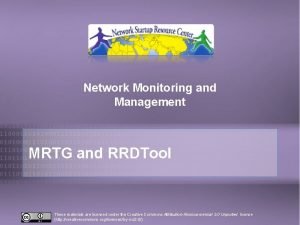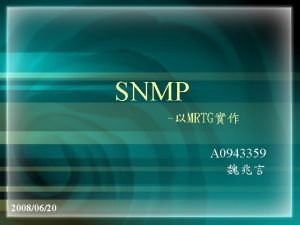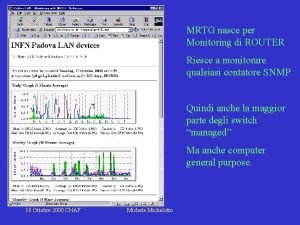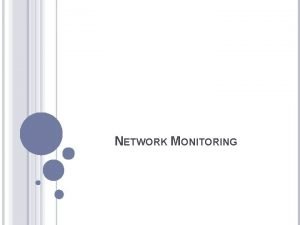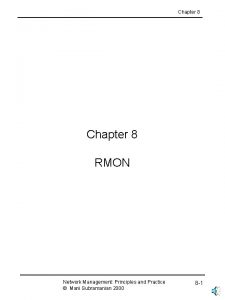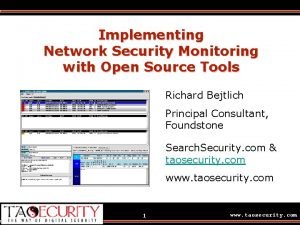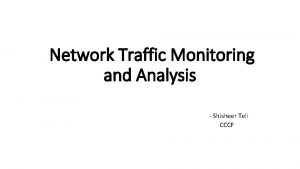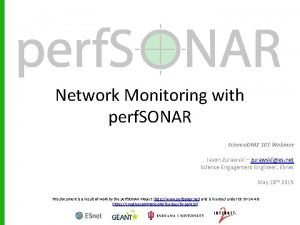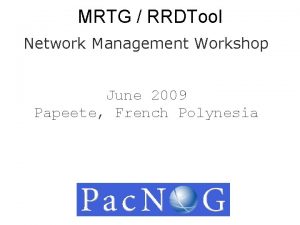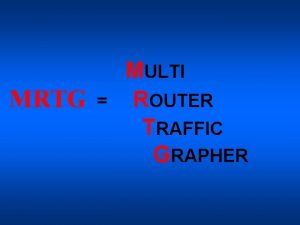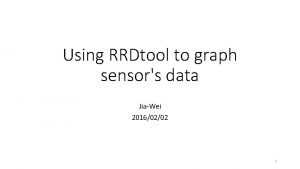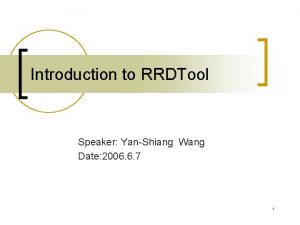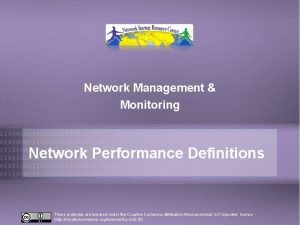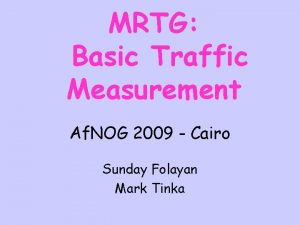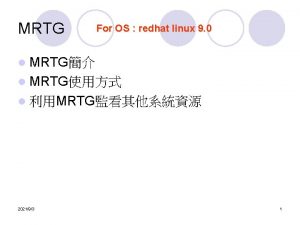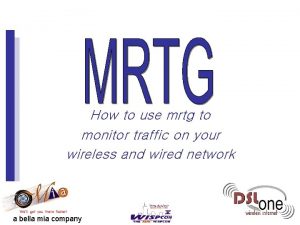Network Monitoring and Management MRTG and RRDTool These















- Slides: 15

Network Monitoring and Management MRTG and RRDTool These materials are licensed under the Creative Commons Attribution-Noncommercial 3. 0 Unported license (http: //creativecommons. org/licenses/by-nc/3. 0/)

MRTG: Multi Router Traffic Grapher • MRTG is a tool to monitor the traffic load on network-links. MRTG generates HTML pages containing PNG images which provide an almost live visual representation of this traffic. You can find MRTG at http: //oss. oetiker. ch/mrtg/. • MRTG has been the most common network traffic measurement tool for all Service Providers. • MRTG uses simple SNMP queries on a regular interval to generate graphs.

MRTG • External readers for MRTG graphs can create other interpretation of data. • MRTG software can be used not only to measure network traffic on interfaces, but also build graphs of anything that has an equivalent SNMP MIB - like CPU load, Disk availability, temperature, etc. . . • Data sources can be anything that provides a counter or gauge value – not necessarily SNMP. • For example, graphing round trip times • MRTG can be extended to work with RRDTool

MRTG: Issues • MRTG generates each graph (what if you have hundreds of graphs!) every 5 minutes, creating a lot of overhead. • It also has very few customizable graphing options. • Disk space is always an issue. • MRTG management itself can be tedious work.

Using MRTG • Get the required packages • Compile and install the packages • Make cfg files for router interfaces with cfgmaker • Create html pages from the cfg files with indexmaker • Trigger MRTG periodically from cron or run it in daemon mode

RRDTool • Round Robin Database for time series data storage • Command line based • From the author of MRTG • Made to be faster and more flexible • Includes CGI and Graphing tools, plus APIs • Solves the Historical Trends and Simple Interface problems as well as storage issues

Defining the Output (Archives) RRA: AVERAGE: 0. 5: 1: 24 RRA: AVERAGE: 0. 5: 6: 10 RRA = Round Robin Archive AVERAGE = consolidation function 0. 5 = up to 50% of consolidated points may be UNKNOWN • 1: 24 = this RRA keeps each sample (average over one 5 minute primary sample), 24 times (which is 2 hours worth) • 6: 10 = one RRA keeps an average over every six 5 minute primary samples (30 minutes), 10 times (which is 5 hours worth) Clear as mud! • All depends on original step size which defaults to 5 minutes

RRDTool Database Format

So simple… rrdtool create /var/nagios/rrd/host 0_load. rrd -s 600 DS: 1 MIN-Load: GAUGE: 1200: 0: 100 DS: 5 MINLoad: GAUGE: 1200: 0: 100 DS: 15 MIN-Load: GAUGE: 1200: 0: 100 RRA: AVERAGE: 0. 5: 1: 50400 RRA: AVERAGE: 0. 5: 60: 43800 rrdtool create /var/nagios/rrd/host 0_disk_usage. rrd -s 600 DS: root: GAUGE: 1200: 0: U DS: home: GAUGE: 1200: 0: U DS: usr: GAUGE: 1200: 0: U DS: var: GAUGE: 1200: 0: U RRA: AVERAGE: 0. 5: 1: 50400 RRA: AVERAGE: 0. 5: 60: 43800 rrdtool create /var/nagios/rrd/apricot-INTL_Ping. rrd s 300 DS: ping: GAUGE: 600: 0: U RRA: AVERAGE: 0. 5: 1: 50400 RRA: AVERAGE: 0. 5: 60: 43800 rrdtool create /var/nagios/rrd/host 0_total. rrd -s 300 DS: IN: COUNTER: 1200: 0: U DS: OUT: COUNTER: 600: 0: U RRA: AVERAGE: 0. 5: 1: 50400 RRA: AVERAGE: 0. 5: 60: 43800

What it looks like… http: //noc. ws. nsrc. org/mrtg/device. html

MRTG In Ubuntu / Debian $ sudo apt-get install mrtg Configuration • /etc/mrtg/<device. mrtg> • Global directory : /var/www/mrtg/ • Run MRTG against the configuration file from cron

cfgmaker Uses snmpwalk and creates an mrtg configuration file /usr/bin/cfgmaker --output=/etc/mrtg/router. mrtg --global 'workdir: /var/www/mrtg’ --global 'options[_]: growright, bits’ Net. Manage@10. 0. 254

Sample Part of /etc/mrtg/device. mrtg ### Interface 1 >> Descr: 'Fast. Ethernet 0/0' | Name: 'Fa 0/0' | Ip: '' | Eth: '' ### Target[10. 0. 254_Fa 0_0]: #Fa 0/0: Net. Manage@10. 0. 254: Set. Env[10. 0. 254_Fa 0_0]: MRTG_INT_IP="" MRTG_INT_DESCR="Fast. Ethernet 0/0" Max. Bytes[10. 0. 254_Fa 0_0]: 12500000 Title[10. 0. 254_Fa 0_0]: Traffic Analysis for Fa 0/0 -- rtr. ws. nsrc. org Page. Top[10. 0. 254_Fa 0_0]: <h 1>Traffic Analysis for Fa 0/0 -- rtr. ws. nsrc. org</h 1>

Creating HTML with indexmaker Execute indexmaker like this: /usr/bin/indexmaker --output=/var/www/mrtg/device. html /etc/mrtg/device. mrtg If your mrtg configuration file is well commented, the html is nice and detailed.

Lab Instructions In a separate file
